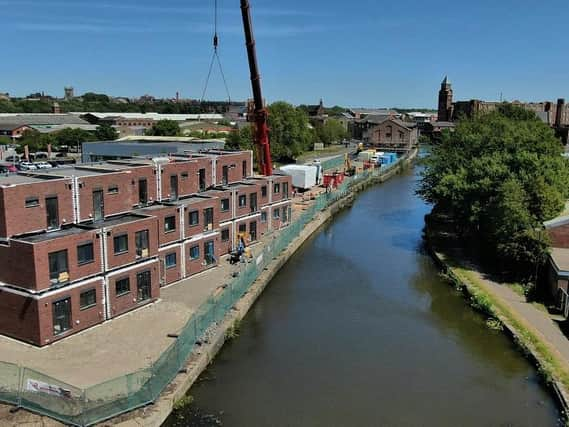Eco-friendly homes at Wigan Pier site pop up in just a matter of days


The eco-friendly modular housing came virtually ready-made on the back of lorries last week and the units were gingerly lowered into place by a large crane to the west of what used to be The Way We Were museum on Wallgate.
The eight dwellings were meant to be the final piece of the project to breathe new life into the site covered by the education centre, museum and what used to be the Orwell.
Advertisement
Hide AdAdvertisement
Hide AdBut because of the Covid-19 lockdown, work particularly on the interior of the three key buildings has slowed and developer Step Places, which is carrying out the Pier Quarter restoration alongside Wigan Council and The Old Courts, predicts that the originally forecast autumn openings are likely to be delayed.
External works have continued after a short recess and that has included the preparation for the grounds of the houses which are only land previously occupied by the museum garden and a recently demolished toilet block close to Seven Stars Bridge.
The last time there were homes overlooking the canal near this point, albeit the backs of them, was in the 1990s. And what were known as Jubilee cottages were well past their best by then and were demolished to make way for the Elizabeth House buildings which is home to the Keep Britain Tidy organisation.
But these new arrivals certainly add to the impression of progress being made at the complex, despite Covid-19-related hold-ups.
Advertisement
Hide AdAdvertisement
Hide AdStep Places development director Gareth Smith said: “The buildings appearing on site are our new modular homes.
“We are the first in the North West to deliver low carbon, efficient living and the setting of Wigan Pier for these canal side houses is perfect.
“We have integrated air source heat pumps and MVHR (mechanical ventilation heat recovery) into each property which dramatically reduced the utility costs for the home owner.
“They are fully built off site then brought to site and craned in.
Advertisement
Hide AdAdvertisement
Hide Ad“The idea is that by building off-site the ability to deliver quality built homes is multiplied exponentially due to the factory setting as you are not building in all different types of weather.
“The actual erection on site takes approximately one week for the eight houses.
“They are finished externally with a brick facade.
“This part of the process is very quick and then we revert back to the external landscaping works.”
With regard to the Wigan Pier complex itself, Mr Smith said that progress is good. Work to the new Pier-side jetties is the main focus at the moment. The old ones were rotten and had to be removed along with their awnings.
Advertisement
Hide AdAdvertisement
Hide AdWhen the premises had their original industrial uses, such walkways did not exist and canal boats would pull right alongside for the loading and unloading of materials.
But when they became a leisure destination in the 1980s, the verandahs were added so that people could look out onto the canals.
Step Places say that they want to replace them rather than ditch them because a) they increase the number of access points from a safety point of view and, b) will make attractive places for people to sit or stand with a drink on a balmy summer’s evening.
While the roads have been much quieter during the pandemic lockdown, the authorities have also taken the opportunity to resurface Wallgate alongside the Pier complex.
Advertisement
Hide AdAdvertisement
Hide AdOnly a small amount of exterior work now needs to be done on the main buildings, after which the remaining scaffolding will finally be taken down. Much time has been spent replacing rotten timberwork in the buildings and using high quality materials to ensure that they are completely waterproofed for years to come.
The education centre will remain as such while the Orwell becomes an events facility and the museum a food hall with micro-brewery adjoining.